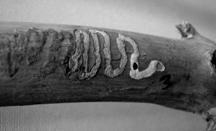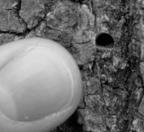Door County Environmental Council Column
- Share
- Tweet
- Pin
- Share
We’ve been trying to keep you up to date with basic information on the newest and nastiest invasive insect to threaten our forest resources, the Emerald Ash Borer. In October 2006, the Door County Environmental Council (DCEC) sponsored an in-depth presentation at Crossroads at Big Creek by Linda Williams, WDNR Forest Health Specialist, addressing the problems associated with this potent, new threat.

Ash trees are 6.8 percent of the total forest population in Wisconsin. In Michigan and Illinois, the borers presently impact mostly urban and roadside areas. At this date, the Emerald Ash Borer is now in Wisconsin, but only in the Milwaukee area.
In her presentation, Linda stressed that if an infestation is found in a specific tree or grove of ash trees, a cutting effort must take place immediately to lessen the spread. All ash trees within a radius of one mile must be cut down and destroyed. When this is done, the likelihood of eradicating the beetle is considerably increased.
This may appear to be a drastic measure to control the spread of these insects, but the alternative would be to let them pursue their destructive agenda. The Emerald Ash Borer prefers ash trees that are under stress and can detect them because they have a scent distinct from that of healthy ash trees.

If an entire woodland has signs of EAB infestation, and is verified, the ash trees are doomed and harvest should take place quickly to reduce the loss of salvageable timber. The intent of the program is to halt the spread from a single infested tree to the surrounding non-infested trees. At this time, the only working solution is removal.
Specialists are working on options: natural enemies, other methods of control, etc.; but as of now, nothing has proven effective. Some commercial business ventures claim to have valid treatments that inject insecticides to control the borer, but these have not yet been proven effective.
We need to be aware of the signs of infestation: upper branches showing loss of leaves and the telltale half-round bore holes in the bark. If you remove some of a suspected tree’s bark and find a serpentine burrow, chances are you may have an infested tree. An expert should be called in for final determination.
Once these signs are present, the tree is doomed and the elimination process should be completed. The alternative is to let the borer proceed and watch the neighboring trees succumb to infestation. The sad result in this case would be similar to Dutch Elm Disease, which destroyed all but the most isolated and strongest elm trees resistant to the disease. (The Gypsy Moth is an entirely different affliction that is easily seen and can be treated with constant spraying practices.)
Let’s hope that controlling predator insects can be found, or other solutions developed, to control this nasty invader from Asia. In the meantime, people need to be conscientious about controlling any imported, out-of-county firewood.
If you would like to hear the DNR presentation and form your own opinions from that information, we will make arrangements for a return by Linda Williams. Please call us at 920.743.6003.
If you suspect an infestation from the signs of stress, serpentine borer tunnels or “D” shaped exit holes, call the Department of Agriculture, Trade and Consumer Protection hotline at 800.462.2803 or call our local DNR Foresters, Bill Ruff or Chris Plzak at 920.746.2880.
For further information on DCEC call 920.743.6003, email [email protected] or visit http://www.dcec-wi.org.
